Books
Books

Nox
Nox is an epitaph in the form of a book, a facsimile of a handmade book Anne Carson wrote and created after the death of her brother. The poem describes coming to terms with his loss through the lens of her translation of “Poem 101” by Catallus “for his brother who died in the Troad.” Nox is a work of poetry, but arrives as a fascinating and unique physical object. Carson pasted old letters, family photos, collages and sketches on pages. The poems, typed on a computer, were added to this illustrated “book” creating a visual and reading experience so amazing as to open up our concept of poetry.

Reading Like a Computer
The contents of Reading Like a Computer. A Sematic Guide to Facebook's Content Moderation Policies are from leaked PowerPoint slides used to train Facebook content moderators. The contents have not been embellished or editorialized. By organizing and graphically presenting the subtle discrepancies between what Facebook allows and doesn’t allow in a post, the book highlights the contradictions and challenging logic of Facebook's community standards.

Sketchbook 1-10
“Sketchbook 1-10” with Antoinette d’Ansembourg bundles a complete collection of pocket sketches created between 2020 and 2023, stretched across ten different notebooks. These sketches, despite their two-dimensionality, form the mainstay of her sculptural output, offering a glimpse into the intimate process behind her stately installations.

Welcome to the Shitshow
“There are three sides to every story: your side, my side, and the truth. Yet, whatever happened at the Shitshow holds six truths.” Welcome to the Shitshow with Casper Boone was launched on Friday, December 2nd at KBK Brussels. We celebrated the birth of our inaugural publication, allied with an exhibition with works by Casper.

My Homies
Published on occasion of Arnaud Eubelen’s solo exhibition My Homies, curated by Jeanne Mouffe presented by Medusa. Enveloped with a poem by Romain Beaudot, the publication, intended to complement the exhibition, traces Arnaud’s footsteps to the conception of his trash-to-treasure practice.
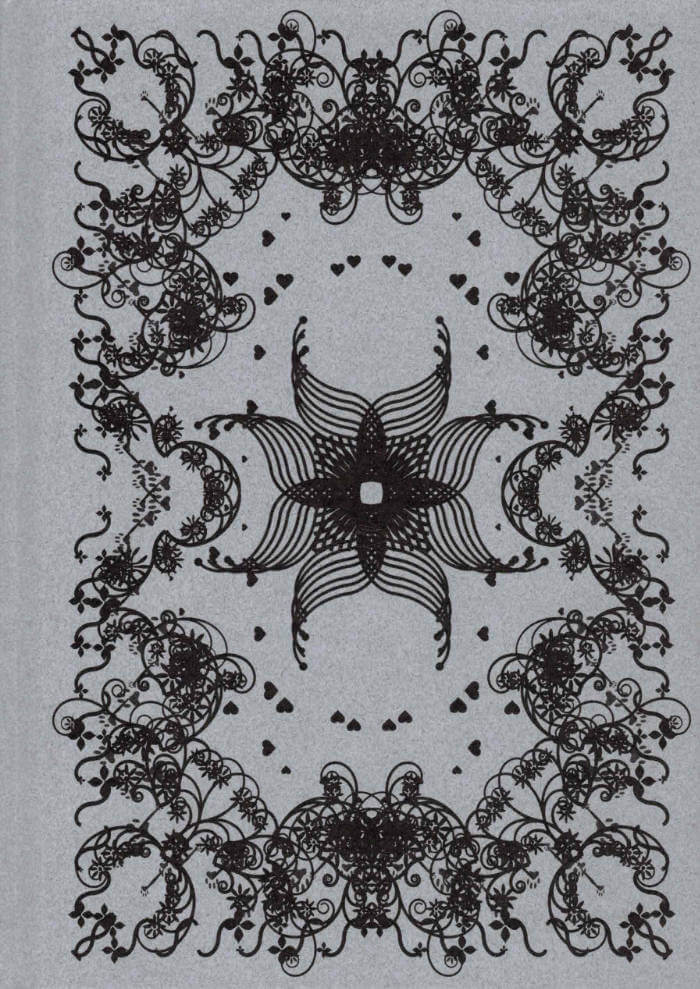
Of Planters; an Herbarium
Published in tumult of “Planters, a garden show” by COUR: with Noëmi Orgaer, Orson Van Beek, Charlotte Bombel, Moreno Schweikle, Shun Yoon, Yen Proesmans, Benny Van den Meulengracht-Vrancx, HansWuyts, Malte van der Meyden, Fritz Adamski, Hannah Kuhlmann, Delphine Lejeune, Grażyna Mielech and Giseok Kim.

Flower Engine
the second poetry collection from Natalie Briggs titled ‘FLOWER ENGINE’. This collection of cinched, bright free-verse explores the passing locations of love and the slow, private operations of pain’s knocking counterweight. The book extends Briggs’ relay of concise universal suggestions, translating them through brief, intimate utility.

Image Storage Containers
Ostensibly as documentarian as his work on The Family of Man, Image Storage Containers (2012) does something closely related in intention to the latter and yet very different. On one level, it can be described as condensing, as Marie Muracciole has noted, two moments in the myth of photography as a “universal language”: the first involving The Family of Man as imperial project; the second, photography’s sheer technicity as a mechanical means of reproduction, with all its attendant connotations ofobjectivity and scientificity.
Atop this interfolding of meanings one can discern two additional layers: the Image Storage Container as a kind of “thought experiment,” an auto-pedagogical exercise to schematize the human nervous system, and, a more polemical read, as a proposition about the present conditions for viewing photographs within today’s networked image regime—at a moment when computer technologies, themselves predicated upon neuroscience findings on human perception and cognition, have precipitated a mass transformation of psycho-social behavior.
With contributions by Michael Baers.

Le Soleil et l’Acier
Le Soleil et l’Acier est un recueil de textes assemblé par Laurianne Bixhain lors de clubs de lecture qui se sont tenus pendant sa résidence au Musée de l’imprimerie et de la carte à jouer de Grevenmacher (Luxembourg). Pour faire écho au travail de Monique Wittig, Roxanne Maillet a dessiné de nouvelles ligatures pour la Baskervvol, notamment une ligature « je ».

CLOUDS
Clouds are, narratively speaking, some tricky things. They are both full and empty. They are vacant and shifting, a site of tension between the material and the immaterial, the perceptible and the invisible. Clouds is also the title of German artist Esther Kläs’ first monograph, which spans over 15 years of sculptures, drawings, and performances. As an organic rendering of a complex practice, this book mirrors both the formal impact of each artwork and the conceptual outreach of a collection of gestures, attitudes, movements, and moods happening around the works. Because Esther’s practice has no tight borders or hard edges. Each piece escapes definition and breaks loose from the patterning power of language. Still, regardless of the medium, everything Kläs does seems to have a common denominator: it is a reiteration of a way of thinking – her way of thinking – through a body in space – her body, as well as a social body.
With four commissioned contributions (Marc Navarro with Ester Partegàs, Julie Boukobza, Chloe Chignell, and Francesco Pedraglio) and six short, loose texts edited by Elena Tavecchia and Kläs herself, the book is a canvas whose patterns shift following the artist’s elaborated work. What stays hovering in the air are sparks of decisions, constant movements, recurrent repetitions, and propositions.

Hortus
The Hortus project is an open investigation into the nature of seemingly common objects through 'Floriography', urban gardens, and the history of female rights. Hortus was inspired by urban gardens in West Amsterdam and created with its plants by Lilia Luganskaia.
Joanna Cresswell about the 'Hortus':
History teaches us that a language of flowers can communicate endless things about the culture in which it emerged, and herein lies Lilia Luganskaia's interest. Taking inspiration from the world of 19th Century sentimental flower books, Hortus presents itself as a set of notes towards a modern handbook for contemporary floriography, considering what the discipline might look like today. By collecting common flora across one year in the urban gardens around her home in Amsterdam and cross-referencing their meanings with publications from the past, Luganskaia reflects on their natures, their roles, and the symbolic familiarity they might hold for the communities living with them. A female artist and reader of the twenty-first century, she seeks out the essence of modern life through her lens, and through flowers, just like the women who came before her.
Lilia Luganskaia (1990) Russian - Dutch multidisciplinary artist and author, based in Amsterdam. In her artistic practice, Lilia uses her background in documentary techniques to focus on what she calls ‘investigating reality’. Her practice is research-based, Lilia decodes abstract notions such as love, tourism, bureaucracy, politics, and feminism through the use of constructed images, sculptures, videos, and installations. One of the key elements of her work is to understand multiple aspects of the photographic image.

Aisopika Aesopica
The bilingual book ‘Aesopica’ documents and extends Rūta Junevičiūtė’s research on the Aesopian language and the influence of political censorship to contemporary collective body, first presented in 2020 as the eponymous solo exhibition at the National Gallery of Art and as a permanent outdoor installation at the Rupert Art Center, Vilnius.
Taking as a starting point the historical phenomenon of Aesopian language, which was widespread in Lithuanian culture during the Soviet era, and in parts of the Russian Empire as early as the 19th century, Junevičiūtė aims to investigate the interrelationship between generations, the gray zones of collective identity creation and the processes of (un)censoring the archives of our bodies.
Aesopian language – a term coined after Ancient Greek fabulist Aesop (gr. Aísōpos), is a type of cryptic communication system, where a text has several layers of meaning often contradictory to each other and which seek to convey official and subversive hidden meanings simultaneously. It is usually employed under conditions of omnipresent state censorship to communicate officially forbidden or taboo subjects and opinions. As a system it contains three members – an author, a censor, and a reader. It uses various modes of circumlocution and euphemisation, innuendo and poetic paraphrasing, which can also be seen as an aesthetic style. It has been advocated for artistic benefits as poetics of omissions, concealment, and travesty. On the other hand, it has been criticized as a sign of conformity and humiliation. In Lithuania, after the fall of the Soviet Union, it has been popularly regarded as a position of dissent, but such an interpretation received criticism from contemporary scholars. “Such a mode of expression is probably as old as censorship itself” – a historian told us.
Text contributors: Alfonsas Andriuškevičius, Edgaras Gerasimovičius, Rūta Junevičiūtė, Goshka Macuga, Anastasia Sosunova, Grėtė Šmitaitė, Tomas Venclova, Ana Vujanović
Language editors: Dangė Vitkienė, Aira Niauronytė, Gemma Lloyd
Translators: Alexandra Bondarev, Erika Lastovskytė, Justinas Šuliokas, Mantė Zagurskytė-Tamulevičienė, Aistis Žekevičius.
Illustrations: Rūta Junevičiūtė.
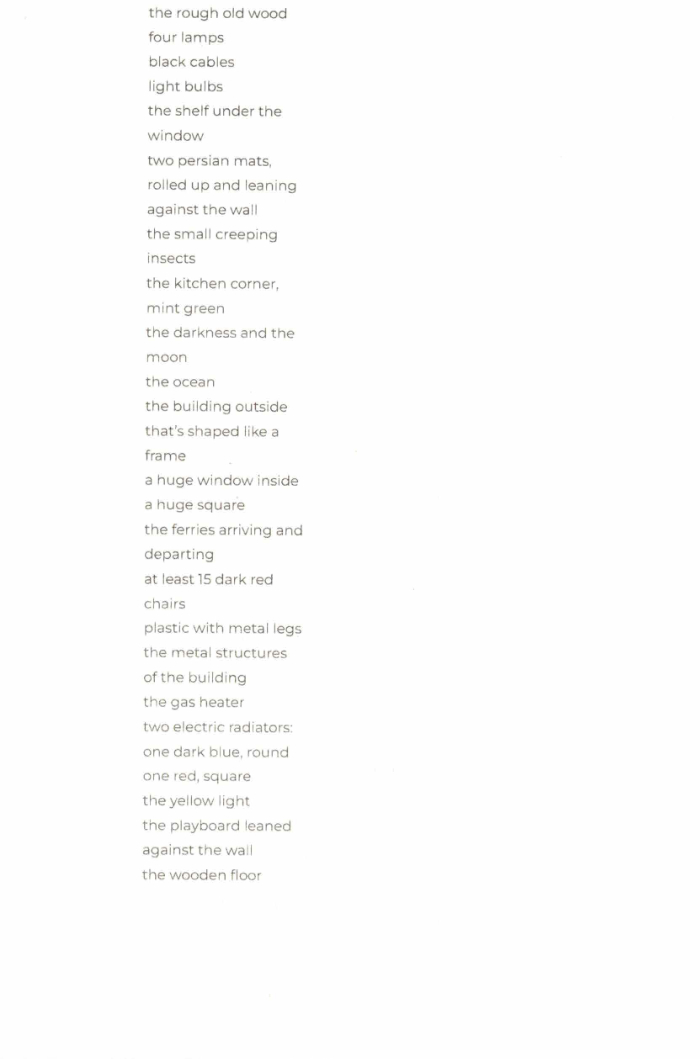
It Absorbs: On Dance as a Porous Art Object
It Absorbs: On Dance as a Porous Art Object is an essay written alongside the making of the piece dead dead document that premiered at MDT in Stockholm 2024. The essay was published in a publication that was presented together with the Reading Edge Library. The text traces contextual and material histories that the process was engaging with and questions the relationship between dance as artistic practice and place aswell as an an economy that force artists to move on.

KAMERA CAHIER N° 10
A special edition issue curated, designed and published by AVARIE, Paris and Labor Neunzehn, Berlin. It accompanies KAMERA SERIES, while it is an independent and valuable object to collect. The central idea that informs and directs the booklets’ montage is the interplay between the concepts of addition and subtraction. This is achieved by unveiling a missing image in the screening or an unreleased second from an artist's film, expanded to 24 pages. Additionally, each booklet contains a piece directly removed from the show.
The editing establishes a dialogue between film frames and performed writings derived from texts, scripts, storyboards, and notes. The KAMERA exhibition is consequently extended into a physical space—the book—allowing for its widespread dissemination, complementing and contrasting with its potential online occurrence.
KAMERA SERIES is a screening program of experimental films, video art works and printed matter taking place in a former GDR building in Berlin. Each event showcases a retrospective of selected films by an artist and a small exhibition of his/her publications or works on paper over a span of 4 days.
KAMERA centers on fostering a critical dialogue between different film formats and artists’ books. Through its regular occurrence, it aspires to create a space for community exchanges about contemporary image-making. KAMERA is a series conceived and curated by Labor Neunzehn and AVARIE.
Fascinated by the intersection of visual art and cinema, Helga Fanderl’s short poetic films evoke intense and sensitive experiences of the real world. Using a small hand-held super 8 camera, she creates filmic responses to her perceptions, weaving together imagery and emotions in dense, rhythmic patterns solely through in-camera editing. She presents silent films in the form of ‘compositions’, crafting unique programs for site-specific personal projections and transforming spaces into temporary cinemas.

KAMERA CAHIER N° 9
Peter Downsbrough (New Jersey, US, 1940) lives and works in Brussels (Belgium). Associated with major international art movements such as minimal art, conceptual art, and visual poetry, his work spans across various mediums including sculpture, wall pieces and room pieces, books, work on paper, photography, film, and video. The work, which has affinities with architecture and typography, explores the traditional use of space and language, while criticizing power structures, e.g. urbanism, that influence social interactions and shape the landscape.
A special edition issue curated, designed and published by AVARIE, Paris and Labor Neunzehn, Berlin. It accompanies KAMERA SERIES, while it is an independent and valuable object to collect.
The central idea that informs and directs the booklets’ montage is the interplay between the concepts of addition and subtraction. This is achieved by unveiling a missing image in the screening or an unreleased second from an artist's film, expanded to 24 pages. Additionally, each booklet contains a piece directly removed from the show.
The editing establishes a dialogue between film frames and performed writings derived from texts, scripts, storyboards, and notes. The KAMERA exhibition is consequently extended into a physical space—the book—allowing for its widespread dissemination, complementing and contrasting with its potential online occurrence.
KAMERA SERIES is a screening program of experimental films, video art works and printed matter taking place in a former GDR building in Berlin. Each event showcases a retrospective of selected films by an artist and a small exhibition of his/her publications or works on paper over a span of 4 days.

Devenir minéral | L’éditeur du dimanche
Echoing Jean Dubuffet's idea that thought must arise from material in artistic practice, Giuliana Prucca, through this essay, reinterprets a moment in the history of 20th-century art using materials such as stone, sand, earth, and dust. She employs the mineral to illustrate that the creative act would be a trace of the body's disappearance. The loss of humanity and the deconstruction of the subject objectify themselves in the image. In other words, art resides in the tension between representation and its loss, ultimately leaving nothing but an image.
Drawing from the influential figure of Antonin Artaud, she weaves critical and poetic connections between the texts and works of various artists, writers, and thinkers, ranging from Jean Dubuffet to Jan Fabre and Anselm Kiefer, Yves Klein and Gutaï, Joë Bousquet to Camille Bryen and Francis Ponge, Gaston Bachelard to Gilles Deleuze, and Georges Bataille to Aby Warburg.
The material is not merely a thematic pretext; it is an active and explosive catapult that questions the arbitrary linearity of a conventionally assimilated art history. Following Ponge's example, Prucca applies the principles of poetry to criticism, starting from Artaud's material, the most undisciplined of poet-artist-thinkers of the modern era. This results in a critically inventive approach dangerously suited to its object, celebrating an anti-critique. The chosen writing materials, stonepaper for the cover and recycled paper for the pages, is consistent, intending to give the impression of being covered in dust.
The essay disrupts traditional reading habits and shatters the conservatism of art criticism by inhabiting writing space differently, presenting a physically engaging interaction. This is an essay in the literal sense, an experience where form never contradicts content, urging readers to take the risk of thinking deeply and embracing a new rhythm. A complex and challenging design invites them to choose different reading options, ultimately treating criticism as one would poetry.
Giuliana Prucca [Paris | Berlin] is an independent curator, researcher, and writer. She is the founder and art director of the publishing house AVARIE, specialising in contemporary art books that explore the relationships between text and image, body and space.
Graphic design, art direction by Vito Raimondi

Movement Research Performance Journal
Movement Research Performance Journal Issue 58/59
Prompt: Movement Research was founded in 1978 as a self-described “laboratory” for investigating dance and movement. In its long history, the organization has prioritized giving space to artists for rehearsing, developing, and investigating—rather than presenting and producing—their work. The Movement Research Performance Journal can be seen as an outgrowth of this mission—extending the rehearsal studio into the space of the page. In its first issue, editor Richard Elovich describes the journal as “a new public space for the New York performance community…a slightly anarchic forum in which opposing ideas and aesthetics can be seriously developed and debated.” How do we understand this mission of staying in the zone of research today? How are artists (re)building pedagogy, and processes of learning, into their practice? What contemporary or historical alternative schools, and approaches to schooling, might be seen in constellation with the founding of Movement Research? How are students of dance and performance confronting the possibility and failure of an educational system predicated on both their enrichment and indebtedness?

Death Book ll
Death Book is dedicated to Bruce LaBruce’s archive of rarely published or previously unpublished work characterized by morbid fascinations. Here photographs challenge the viewer to explore what lies beneath the veneer of Western society.
The book brings this body of work together for the first time, combining LaBruce’s performances, actions, film production stills and photography that explicitly outline his obsessions, with never-before exhibited archival works from projects including Hustler White, Otto; or Up with Dead People, and L.A. Zombie.
The book is edited as loosely connected vignettes, characterised by horror, the carnage accelerated rather than overcome, questioning existing values, hierarchies, and perceptions of good and evil. A variety of faces and body parts appear, including those of actors Francois Sagat and Tiger Tyson, model/actor Tony Ward, artists Kembra Pfahler and Slava Mogutin, and cameos by legendary figures such as performance artist Ron Athey, musician/artists Genesis P-Orridge and Lady Jaye, artist Dash Snow, actor Brad Renfro, Asia Argento and Bruce LaBruce himself.
The Death Book also introduces the art director Max Siedentopf, who has designed the book as a paraphrase of the Bible, punctured with three bullet holes, piercing the book from front to back. The book contains an introduction by artist, photographer and writer Slava Mogutin.
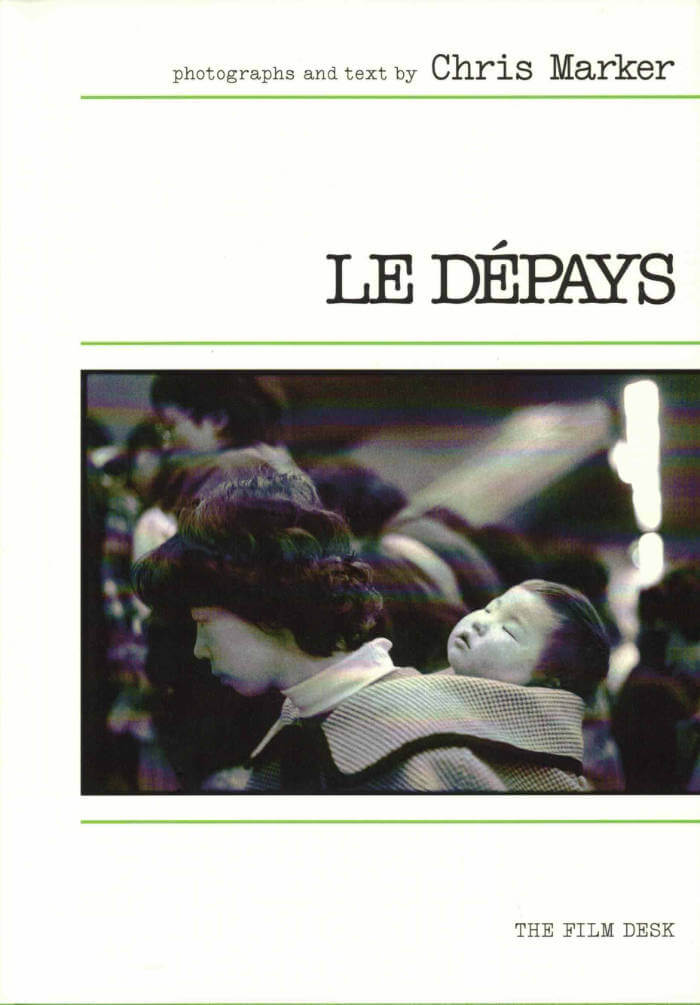
Le Dépays
This is the first English language edition of Chris Marker’s 1982 photo-essay, Le Dépays. Lovingly adapted from the original design, it features Marker’s own translation astride some of his most exquisite, yet rarely seen, black-and-white photography. Realized over the same years as its film companion, Sans Soleil, the book traces similar themes—cats and owls and Japan—but without ever leaving Golden-Gai for Guinea-Bissau. Musing among department store maneki-neko and dreamers on the metro, wandering between Tokyo and no-place at all, this is nevertheless a unique glimpse of Marker feeling very much himself and quite at home; that is, delightfully disoriented.
“Inventing Japan is just another way of getting to know it . . . Trust appearances, consciously confuse the decor with the drama, never worry about understanding, just be there—dasein—and everything will come your way. Well, something, at least . . .”—Chris Marker, from Le Dépays Chris Marker, 1921–2012.
Filmed, photographed, traveled, loved cats.
With a new introduction by writer and artist Sadie Rebecca Starnes.
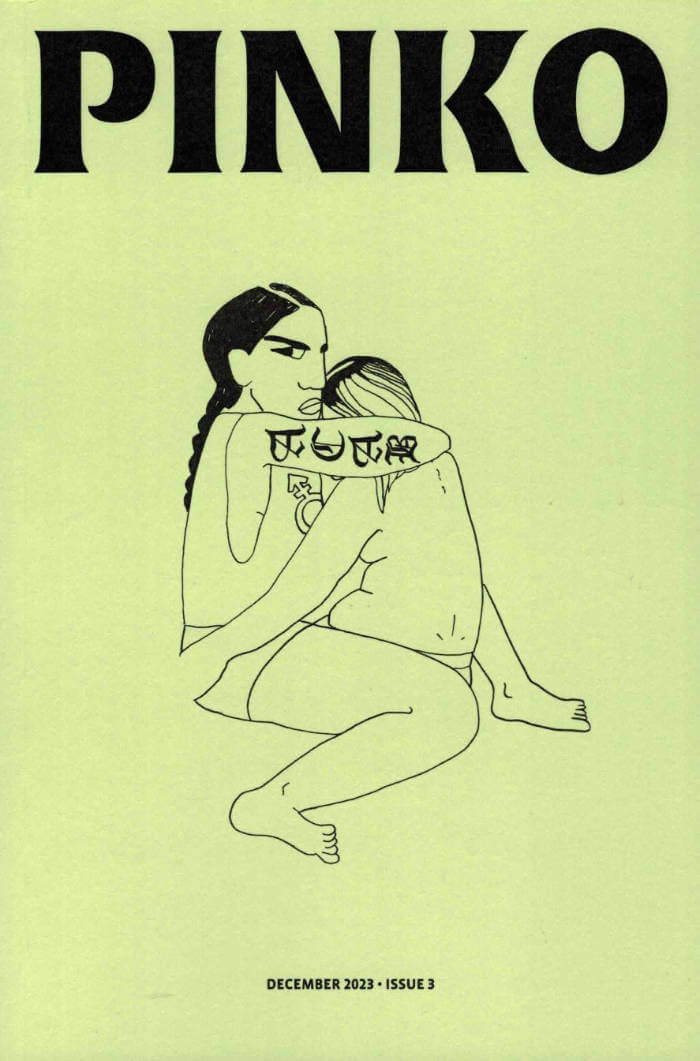
Pinko Magazine Issue 3
This third print issue contains Pinko's editorials on trans eradication and Palestinian survival, essays about black lesbian sex writing, consent and its limits, the end of sexual liberalism, and a presentation of imbrication theory, plus a roundtable on political violence, an interview from Pinko's book After Accountability, and a memorial to the gay socialist publisher Jeffrey Escoffier. Illustrations by the artist KT Pe Benito grace this issue.

Pinko Magazine Issue 2
This second print issue contains an interview with the abolitionist organizer Stevie Wilson, essays about nineties nightlife in support of queer intimacies in Santiago, Chile, Barbz against pinkwashing, a translation of the communization theorist Gilles Dauvé’s latest work on the reactionary tendencies in the sexual liberation movement in Weimar Germany, a missive by Samuel R. Delany, a ritual script by Lou Cornum, a meditation on intersex experiences as the untheorized marrow of trans liberation, and more. There are also world-building drawings by the artist Chitra Ganesh throughout.

Issue 9: John Akomfrah
This special, limited-edition issue of Plaster celebrates Akomfrah’s commission for the British Pavilion at the 60th International Art Exhibition, La Biennale di Venezia. The linen presentation box contains: an essay by Akomfrah’s long-time friend and collaborator, the BAFTA-winning film curator June Givanni; an interview with Akomfrah by Harriet Lloyd-Smith; original portraits by photographer Siam Coy and a fold-out poster featuring an exclusive still from Akomfrah’s film installation, Listening All Night To The Rain, now screening in the British Pavilion at the Venice Biennale.
With creative direction by Constantine // Spence and design by Emma Ralph.
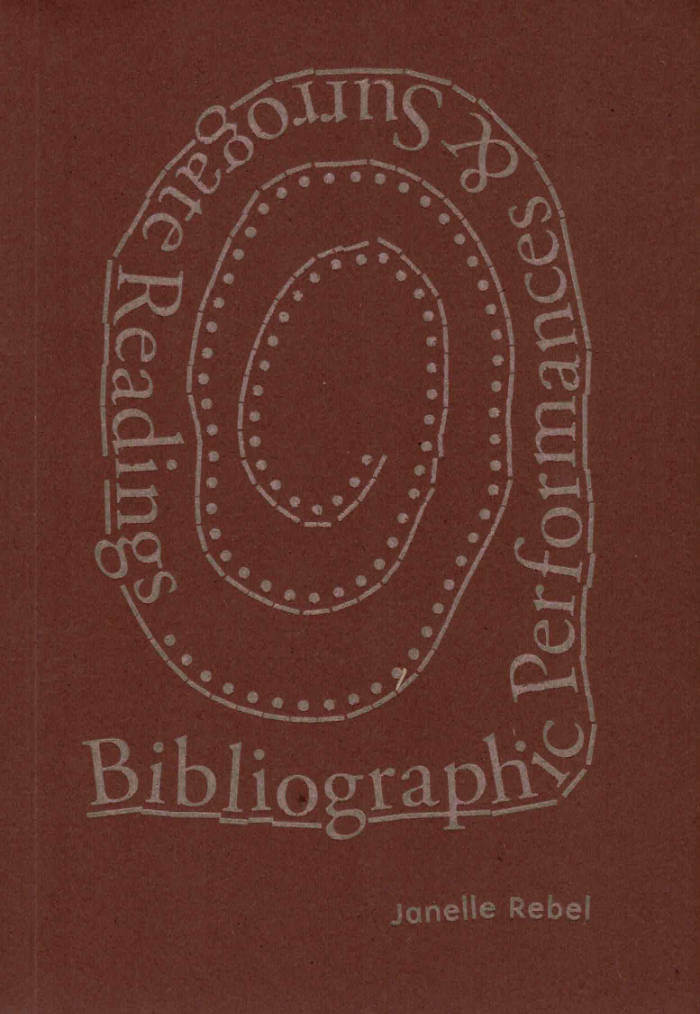
Bibliographic Performances & Surrogate Readings
Bibliographic Performances & Surrogate Readings delves into the imaginative realm of books and libraries and the interpretive structures of subject bibliographies.
It is the first monograph of its kind to historicize, theorize, and survey two decades of what the author refers to as contemporary visual bibliography or experimental subject bibliography—artistic and poetic projects that explore artifactual, intellectual, spatial, and design possibilities.
Ranging from artists’ books and web data-bases to stack interventions and reading room installations, Bibliographic Performances & Surrogate Readings reviews over fifty compelling visio-bibliographic examples created by diverse, international cultural workers.
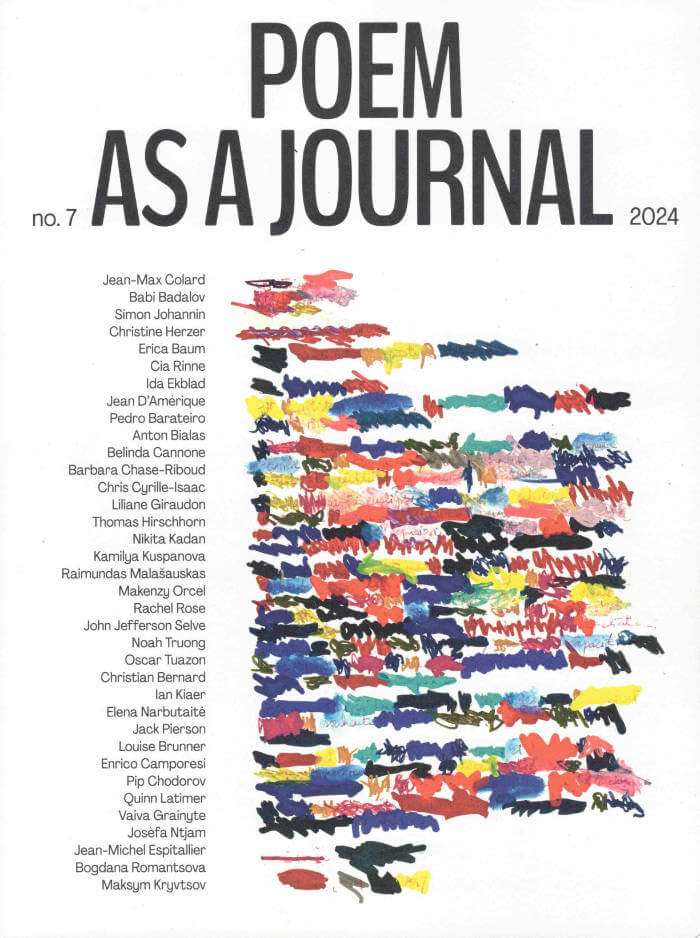
Issue 7: Poem as a Journal
What sparked off this issue of as a Journal was the clear evidence of poetry’s growing presence in the field of contemporary art. Rather than ‘Poetry’ in general, and even less so the figure of the ‘Poet’, it’s the poem that has our full attention: I find it in the title of an exhibition by Jason Dodge, on the invitation card sent out by artist Ida Ekblad, and then again in the form of an exhibition, in the display and arrangement of works within a space by Ian Kiaer, Elena Narbutaitė or Wolfgang Tillmans. Hence this open-ended question, ‘What is poetry for you today?’, placed like a probe among various art world players, in a sort of vox populi.
And so rises the confirmation of an intuition: in an art field driven by the market, where artworks are becoming luxury accessories for the jet set, poetry, with its poverty and economy of means, appears at the opposite end of the spectrum, as a pole of resistance.